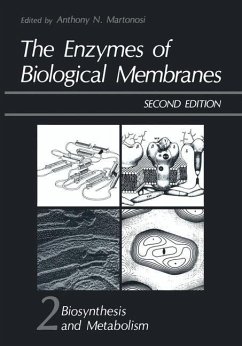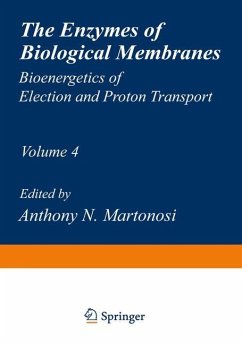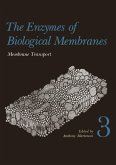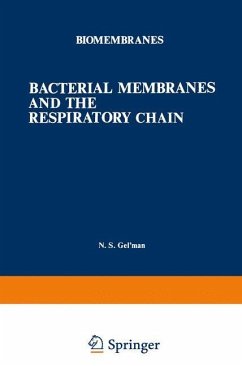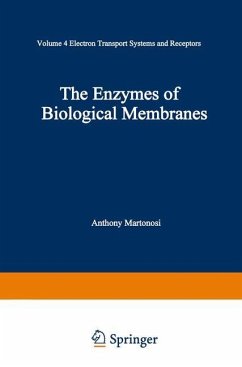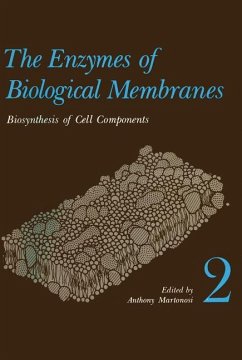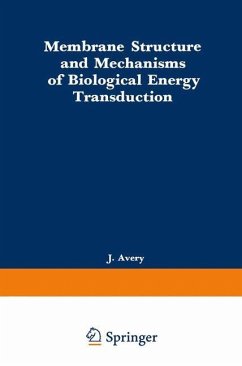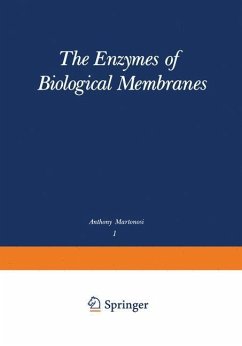The Enzymes of Biological Membranes
Volume 2 Biosynthesis and Metabolism
Herausgegeben:Martonosi, Anthony N.
The Enzymes of Biological Membranes
Volume 2 Biosynthesis and Metabolism
Herausgegeben:Martonosi, Anthony N.
- Broschiertes Buch
- Merkliste
- Auf die Merkliste
- Bewerten Bewerten
- Teilen
- Produkt teilen
- Produkterinnerung
- Produkterinnerung
In the first edition of The Enzymes of Biological Membranes, published in four volumes in 1976, we collected the mass of widely scattered information on membrane-linked enzymes and metabolic processes up to about 1975. This was a period of transition from the romantic phase of membrane biochemistry, preoccupied with conceptual developments and the general properties of membranes, to an era of mounting interest in the specific properties of membrane-linked enzymes analyzed from the viewpoints of modem enzymology. The level of sophistication in various areas of membrane research varied widely;…mehr
Andere Kunden interessierten sich auch für
![The Enzymes of Biological Membranes The Enzymes of Biological Membranes]() The Enzymes of Biological Membranes82,99 €
The Enzymes of Biological Membranes82,99 €![The Enzymes of Biological Membranes The Enzymes of Biological Membranes]() Anthony MartonosiThe Enzymes of Biological Membranes41,99 €
Anthony MartonosiThe Enzymes of Biological Membranes41,99 €![Bacterial Membranes and the Respiratory Chain Bacterial Membranes and the Respiratory Chain]() N. S. Gel manBacterial Membranes and the Respiratory Chain41,99 €
N. S. Gel manBacterial Membranes and the Respiratory Chain41,99 €![The Enzymes of Biological Membranes The Enzymes of Biological Membranes]() Anthony N. MartonosiThe Enzymes of Biological Membranes41,99 €
Anthony N. MartonosiThe Enzymes of Biological Membranes41,99 €![The Enzymes of Biological Membranes The Enzymes of Biological Membranes]() Anthony MartonosiThe Enzymes of Biological Membranes41,99 €
Anthony MartonosiThe Enzymes of Biological Membranes41,99 €![Membrane Structure and Mechanisms of Biological Energy Transduction Membrane Structure and Mechanisms of Biological Energy Transduction]() Membrane Structure and Mechanisms of Biological Energy Transduction41,99 €
Membrane Structure and Mechanisms of Biological Energy Transduction41,99 €![The Enzymes of Biological Membranes The Enzymes of Biological Membranes]() Anthony N. MartonosiThe Enzymes of Biological Membranes41,99 €
Anthony N. MartonosiThe Enzymes of Biological Membranes41,99 €-
-
-
In the first edition of The Enzymes of Biological Membranes, published in four volumes in 1976, we collected the mass of widely scattered information on membrane-linked enzymes and metabolic processes up to about 1975. This was a period of transition from the romantic phase of membrane biochemistry, preoccupied with conceptual developments and the general properties of membranes, to an era of mounting interest in the specific properties of membrane-linked enzymes analyzed from the viewpoints of modem enzymology. The level of sophistication in various areas of membrane research varied widely; the structures of cytochrome c and cytochrome b were known s to atomic detail, while the majority of membrane-linked enzymes had not even been isolated. In the intervening eight years our knowledge of membrane-linked enzymes ex panded beyond the wildest expectations. The purpose of the second edition of The Enzymes of Biological Membranes is to record these developments. The first volume describes the physical and chemical techniques used in the analysis of the structure and dynamics of biological membranes. In the second volume the enzymes and met abolic systems that participate in the biosynthesis of cell and membrane components are discussed. The third and fourth volumes review recent developments in active transport, oxidative phosphorylation and photosynthesis.
Hinweis: Dieser Artikel kann nur an eine deutsche Lieferadresse ausgeliefert werden.
Hinweis: Dieser Artikel kann nur an eine deutsche Lieferadresse ausgeliefert werden.
Produktdetails
- Produktdetails
- Verlag: Springer / Springer US / Springer, Berlin
- Artikelnr. des Verlages: 978-1-4612-9442-9
- Softcover reprint of the original 1st ed. 1985
- Seitenzahl: 476
- Erscheinungstermin: 5. Oktober 2011
- Englisch
- Abmessung: 254mm x 178mm x 26mm
- Gewicht: 887g
- ISBN-13: 9781461294429
- ISBN-10: 1461294428
- Artikelnr.: 39678464
- Herstellerkennzeichnung Die Herstellerinformationen sind derzeit nicht verfügbar.
- Verlag: Springer / Springer US / Springer, Berlin
- Artikelnr. des Verlages: 978-1-4612-9442-9
- Softcover reprint of the original 1st ed. 1985
- Seitenzahl: 476
- Erscheinungstermin: 5. Oktober 2011
- Englisch
- Abmessung: 254mm x 178mm x 26mm
- Gewicht: 887g
- ISBN-13: 9781461294429
- ISBN-10: 1461294428
- Artikelnr.: 39678464
- Herstellerkennzeichnung Die Herstellerinformationen sind derzeit nicht verfügbar.
of Volume 2.- 14. Ether-Linked Glycerolipids and Their Bioactive Species: Enzymes and Metabolic Regulation.- I. Introduction.- II. Ether Lipid Precursors.- A. Acyl-CoA Reductase.- B. Acyl-CoA:Dihydroxyacetone-P Acyltransferase (EC 2.3.1.42).- III. Biosynthesis of Alkyl and Alk-l-enyl (Plasmalogen) Glycerolipids.- A. Alkyldihydroxyacetone-P Synthase.- B. NADPH:Alkyldihydroxyacetone-P Oxidoreductase.- C. NADPH: Alky ldihydroxyacetone Oxidoreductase.- D. ATP: 1 -Alkyl-sn-glycerol Phosphotransferase (EC 2.7.1.93).- E. ATP:Alkyldihydroxyacetone Phosphotransferase (EC 2.7.1.84).- F. Acyl- oA:l-Alkyl-2-lyso-sn-glycero-3-P Acyltransferase (Ec 2.3.1.63).- G. Acyl-CoA:1-Alkyl-2-acyl-sn-glycerol Acyltransferase.- H. Acyl-CoA:Alkylglycerol Acyltransferase.- I. l-Alkyl-2-acyl-sn-glycerol.CPD-Choline (or CDP-ethanolamine) Choline(ethanolamine)phosphotransferase.- J. -Alk-1'-enyl-2-acyl-sn-glycerol:CDP-Choline (or CDP-ethanolamine) Choline(ethanolamine)phosphotransferase.- K. 1 -Alkyl-2-acyl-sn-glycero-3-hosphoethanolamine esaturase (EC 1.14.99.19).- L. Acyl-CoA:l-Radyl-2-lyso-sn-glycero-3-phosphocholine (or hosphoethanolamine) Acyltransferase (EC 2.3.1.25).- M. Ca2+-Dependent Base Exchange Reactions.- IV. Biologically Active Alkyl Phospholipids (Platelet-ActivatingFactor).- A. Acetyl-CoA: l-Alkyl-2-lyso-sn-glycero-3-phosphocholine Acetyltransferase.- B. l-Alkyl-2-acetyl-sn-glycerol:CDP-Choline Cholinephosphotransferase.- C. 1-Alkyl-2-acetyl-sn-glycero-3- phosphocholine Acetylhydrolase.- D. Pte - H4-Dependent Alkyl Monooxygenase (EC 1.14.16.5).- V. Catabolism of Alkyl and Alk-l-enyl (Plasmalogen)Glycerolipids 31.- A. NAD+: Fatty Alcohol Oxidoreductase.- B. Pte - H4-Dependent Alkyl Monooxygenase (EC 1.14.16.5).- C. Alkenylglycerophosphocholine(ethanolamine)hydrolase (EC3.3.2.2) Plasmalogenase) 33 - D. Phosphohydrolases.- D. Phosphohydrolases.- E. Lipases.- F. Phospholipases.- VI. Assessment of the Prominence of the Acyl-DHAP and Ether Lipid Pathways in Complex Systems.- VII. Regulation of Ether Lipid Metabolic Pathways.- A. Turnover of Ether-Linked Glycerolipid Species.- B. Ether Lipid Precursors and Alkyl Glycerolipids.- C. Alk-l-enyl Glycerolipids (Plasmalogens).- D. Bioactive Alkyl Phospholipids.- References.- 15. Fatty Acid Synthetases of Eukaryotic Cells.- I. Introduction.- II. Fatty Acid Synthetases of Eukaryotes.- A. Animal Fatty Acid Synthetases.- B. Yeast Fatty Acid Synthetase.- III. Component Activities.- A. Acetyl and Malonyl Transacylases.- B. ?-Ketoacyl Synthetase (Condensing Enzyme).- C. (3-Ketoacyl and Enoyl Reductases.- D. ?-Hydroxyacyl Dehydratase.- E. Palmitoyl Thioesterase.- IV. Mechanism of Action of Fatty Acid Synthetase.- A. Animal.- B. Yeast.- References.- 16. Properties and Function of Phosphatidylcholine Transfer Proteins.- I. Introduction.- II. Phosphatidylcholine Transfer Protein from Bovine Liver.- A. Introductory Remarks.- B. Mode of Action.- C. Molecular Aspects.- D. oncluding Remarks.- III. Phosphatidylcholine Transfer Protein from Rat Liver.- A. Some Characteristics.- B. Levels in Various Tissues.- IV. General Conclusions.- References.- 17. Carnitine Palmitoyltransferase and Transport of Fatty Acids.- I. Introduction.- A. Metabolic Fate of Long-Chain Fatty Acids.- B. Role of Carnitine in Fatty Acid Oxidation.- C. Carnitine Acyltransferases.- D. Carnitine Esther Hydrolase.- II. Assays.- A. General Comments.- B. Isotope-Exchange Method.- C. Forward Reaction.- D. Backward Reaction.- III. Mitochondrial Localization.- A. Intracellular Localization 143.- B. Functional Studies in Mitochondria.- C.Mitochondrial Membrane Fractionation.- D. Substrate-Specificity Studies in Mitochondria.- IV. Purification and Characterization of Carnitine Palmitoyltransferase.- A. Purified Carnitine Palmitoyltransferase.- B. Relationship of Purified Enzymes to Functional Localization in Mitochondria.- C. Properties of Membrane-Bound Carnitine Palmitoyltransferase.- D. Reversibility of Carnitine Palmitoyltransferase B.- V. Carnitine Palmitoyltransferase and Mitochondrial Fatty Acid Oxidation.- A. Is Carnitine Palmitoyltransferase Rate-Limiting Step for Fatty Acid Oxidation? The Role of Malonyl-CoA.- B. Carnitine Palmitoyltransferase A.- VI. Carnitine-Acylcarnitine Translocase.- VII. Carnitine Palmitoyltransferase: Substrate Specificity.- A. Carnitine.- B. Acylcarnitine and Acyl-CoA.- VIII. Inhibitors of Carnitine Palmitoyltransferase.- A. 2-Tetradecylglycidic Acid.- B. 2-Substituted Oxiran-2-Carbonyl- CoA Esters.- C. 1-Pyrenebutyryl-CoA.- D. Carba-analogue of Palmitoyl-CoA.- E. Acyl-d-carnitine.- F. 2-Bromoacyl Derivatives.- IX. Changes in Tissue Enzymatic Activity.- A. Increases in Carnitine Palmitoyltransferase Activity.- B. Decreases in Carnitine Palmitoyltransferase Activity.- C. Changes in Distribution of CPT-A and CPT-B.- D. Metabolic Myopathies Associated with Carnitine Palmitoyltransferase Deficiency.- X. Summary and Future.- References.- 18. Membrane-Bound Enzymes of Cholesterol Biosynthesis: Resolution and Identification of the Components Required for Cholesterol Synthesis from Squalene.- I. Introduction.- A. Scope.- B. Objectives.- II. Squalene Synthetase.- A. Purification Methods.- B. Mechanism.- III. Squalene Oxidase.- A. Squalene Epoxidase.- B. Squalene 2,3-Oxide-lanosterol Cyclase.- C. Cytosolic Protein Effectors.- D. Mechanism.- IV. Oxidative Demethylation of C-32from Lanosterol.- A. Metabolite Identification.- B. Cytochrome P-450 Involvement.- V. Steroid 14-Reductase.- A. Description of Enzymatic Activity.- B. Solubilization.- VI. Oxidative Demethylation of 4,4-Dimethyl Sterols.- A. Methyl Sterol Oxidase.- B. Decarboxylase.- C. 3-Ketosteroid Reductase.- D. Cytosolic Protein Effectors.- VII. ?8 ?7 Isomerase.- A. Purification Data.- B. Mechanism.- VIII. ?5-Desaturase.- A. Purification and Reconstitution.- B. Mechanism.- C. Cytosolic Protein Effectors.- IX. 7-Dehydrocholesterol ?7 -Reductase.- A. Purification Data.- B. Cytosolic Protein Effectors.- C. Mechanism.- X. A24-Sterol 24-Reductase.- A. Purification Data.- B. Mechanism.- XI. Coordinate Control Mechanisms of Sterol Synthetic Enzymes.- A. HMG-CoA Reductase.- B. Multilevel Control.- C. Soluble-Protein Involvement.- References.- 19. Membrane-Bound Enzymes in Plant Sterol Biosynthesis.- I. Introduction.- II. Initial Stages.- A. HMG-CoA Reductase (EC 1.1.1.34).- B. Farnesyl Pyrophosphate (EC 2.5.1.1): Squalene Synthesis.- III. Cyclization of Squalene.- A. Squalene Monooxidase (EC 1.14.99.7).- B. Oxidosqualene Cyclases.- IV. Formation of Sterols from Cycloartenol.- A. S-Adenosylmethionine: ?24-Triterpene Methyl Transferase.- B. Cycloeucalenol:Obtusifoliol Isomerase 217.- C. S-Adenosylmethionine:24-Methylenelophenol Transferase.- D. ?25-Sterol Reductase.- V. Glycosylation of Phytosterols and Acylation of Sterol Glycosides.- A. Uridine Diphosphate Glucose:Sterol Transglucosylase.- B. Phosphatidylethanolamine: Sterol Transacylase.- VI. Esterification of Sterols.- A. Diacylglycerol:Sterol Acyltransferase.- VII. Hydrolysis of Sterol Esters.- VIII. Summary.- References.- 20. Glycosyltransferases Involved in the Biosynthesis of Protein-Bound Oligosaccharides of theAsparagine-N-Acetyl-D-Glucosamine and Serine (Threonine)-N-Acetyl-D-Galactosamine Types.- I. Introduction.- II. Asn-GlcNAc Oligosaccharide Structure.- III. Asn-GlcNAc Oligosaccharide Initiation and Processing.- IV. Synthesis of Nonbisected Bi-Antennary Complex N-Glycosyl Oligosaccharides.- A. UDP-GlcNAc:?-D-Mannoside (GlcNAc to Man? 1-3) ßl-2-GlcNAc- Transferase I.- B. GlcNAc-Transferase-I-Dependent ?3/6-Mannosidase(s) (Mannosidase II).- C. UDP-GlcNAc:?-D-Mannoside (GlcNAc to Man? l-6) ßl-2-GlcNAc-Transferase II.- D. UDP- Gal:GlcNAc ß1-4-Galactosyltransferase.- E. CMP-NeuNAc:Galßl- 4GlcNAc ?2-6-Sialyltransferase.- F. CMP-NeuNAc:Galßl-3(4)GlcNAc ?2-3-Sialyltransferase.- G. GDP-Fuc:ß-N-Acetylglucosaminide (Fuc to Asn-Linked GlcNAc) ? l-6-Fucosyltransferase.- H. GDP-Fuc:ß- Galactoside ? 1-2-, ? 1-3-, and ? 1-4-Fucosyltransferases.- V. Synthesis of Bisected Oligosaccharides.- A. UDP-GlcNAc:GnGn (GlcNAc to Manßl-4) ßl-4-GlcNAc-Transferase III.- B. Hybrid Oligosaccharide Synthesis 249.- C. Elongation Reactions on Bisected Oligosaccharides.- VI. Synthesis of Tri-Antennary N-Glycosyl Oligosaccharides.- A. UDP-GlcNAc:GnGn (GlcNAc to Man? l-3) ßl-4-GlcNAc-Transferase IV.- B. UDP-GlcNAc:GnGn (GlcNAc to Man) ßl-6-GlcNAc- Transferase V.- C. Elongation of Tri- and Tetra-Antennary Oligosaccharides.- VII. Ser(Thr)-GalNAc Oligosaccharide Structures.- VIII. Initiation of Ser(Thr)-GalNAc Oligosaccharide Synthesis.- IX. Synthesis of Ser(Thr)-GalNAc Oligosaccharides.- A. Assembly of Oligosaccharides with Core Class 1.- B. Synthesis of Oligosaccharides with Core Class 2.- C. Synthesis of Oligosaccharides with Core Classes 3 and 4.- X. Concluding Remarks: Control of Synthesis.- References.- 21. Biosynthesis of the Bacterial Envelope Polymers Teichoic Acid andTeichuronic Acid.- I. Introduction.- II. Teichoic Acid Structure.- A. Poly(Alditol Phosphate.- B. Polymers with Glycosyl Residues as Part of the Chain.- C. Sugar 1-Phosphate Polymers.- D. Attachment of Wall Teichoic Acids to Peptidoglycan.- III. Biosynthesis of Teichoic Acids.- A. Synthesis of Nucleotide Precursors.- B. Biosynthesis of Poly(Alditol Phosphate) Polymers.- C. Biosynthesis of Teichoic Acids with Sugar Residues in the Main Chain.- D. Addition of Glycosyl and Alanyl Substituents.- IV. Teichuronic Acid Structure and Synthesis.- V. Incorporation of Teichoic Acid and Teichuronic Acid into the Cell Wall.- VI. Synthesis of Membrane Lipoteichoic Acid.- VII. Mode of Action of the Enzymes in the Membrane.- VIII. Regulation of Synthesis of Teichoic and Teichuronic Acids.- References.- 22. The Major Outer Membrane Lipoprotein of Escherichia coli: Secretion, Modification, and Processing.- I. Introduction.- II. The Structure of Lipoprotein and Its Gene.- III. Secretion of Lipoprotein across the Cytoplasmic Membrane.- A. Characterization of Prolipoprotein, the Secretory Precursor of Lipoprotein.- B. Role of the Lipoprotein Signal Peptide in Translocation across the Cytoplasmic Membrane.- C. Analysis of Mutations Involving the Prolipoprotein Signal Peptide.- IV. Modification and Processing of Lipoprotein.- A. Formation of Glyceryl Prolipoprotein 320.- B. Formation of Glyceride Prolipoprotein.- C. Proteolytic Cleavage of the Prolipoprotein Signal Peptide.- D. Acylation of Apolipoprotein.- E. Peptidoglycan Attachment of Mature Lipoprotein.- V. Conclusions.- References.- 23. Anchoring and Biosynthesis of a Major Intrinsic Plasma Membrane Protein: The Sucrase-Isomaltase Complex of the Small-Intestinal Brush Border.- I. Introduction.- II. Gross Positioning.- III. Detailed Positioning.- IV. Pro-Sucrase-Isomaltase, a Fully Enzymatically Active Precursor.- V. Biosynthesis of Pro-SI.- References.- 24. Multifunctional Glucose-6-Phosphatase: A Critical Review.- I. Introduction.- II. Reviews.- III. Newer Methods of Assay.- IV. Purification and Physical Characteristics.- V. Recent Mechanistic Studies.- VI. Newer Reports on the Distribution of Glucose-6-phosphatase.- VII. Zonal Distribution of the Hepatic Enzyme.- VIII. Regulation of Glucose-6-phosphatase Activities.- A. Inhibitors and Activators.- B. Control by Protein Phosphorylation-Dephosphorylation.- C. Control by in Vivo Perturbations.- D. Newer Techniques for Study of the Bioregulation of Glucose-6-phosphatase.- IX. Membrane Phospholipids and Glucose-6-phosphatase Action.- A. Synopsis of Relevant Earlier Work.- B. Recent Studies of Phospholipid Requirements.- C. Some Tentative Conclusions.- X. The Molecular Basis of Latency.- A. Historical Considerations.- B. The "Membrane-Sidedness" and "Constrained-Unconstrained Conformer" Hypotheses.- C. The Translocase-Catalytic Unit Hypothesis.- D. A Proposed Synthesis of the Membrane Conformational and Translocase-Catalytic Unit Concepts.- E. Behavior of the Enzyme in Intact Endoplasmic Reticulum of Isolated Permeable Hepatocytes.- F. Some Tentative Conclusions.- XI. Metabolic Considerations.- A. Muscle.- B. Brain.- C. Liver.- References.- 25. The ß-Adrenergic Receptor: Elucidation of Its Molecular Structure.- I. Historical Perspective.- II. Adrenergic Receptors and Adenylate Cyclase.- III. Molecular Components of Adrenergic Responsive Adenylate Cyclase Systems.- IV. Purification of ß-Adrenergic Receptors.- A. Solubilization of ß-Adrenergic Receptors.- B. Affinity Chromatography of ß-Adrenergic Receptors.- V. Molecular Identification ofß-Adrenergic Receptors.- A. Visualization of the Purified Receptor Peptide(s).- B. Photoaffinity Labeling of ß-Adrenergic Receptors.- C. Radiation Inactivation Studies of ß-Adrenergic Receptors.- VI. Summary and Perspectives.- References.- 26. Ionic Channels and Their Metabolic Control.- I. Introduction.- II. Peculiarities of Different Types of Membrane Ionic Channels.- A. Selectivity.- B. Sensitivity to Changes in Intracellular Ionic Composition.- C. [Ca2 +]i-Activated Channels.- III. Metabolic Regulation of Ionic Channels.- A. Activity of Calcium Channels Dependent on Metabolism.- B. Data on Metabolic Dependence of the Activity of Ca-Dependent Potassium Channels.- C. Possible Metabolic Dependence of the Activity of Other Types of Ionic Channels.- IV. Conclusion.- References.
of Volume 2.- 14. Ether-Linked Glycerolipids and Their Bioactive Species: Enzymes and Metabolic Regulation.- I. Introduction.- II. Ether Lipid Precursors.- A. Acyl-CoA Reductase.- B. Acyl-CoA:Dihydroxyacetone-P Acyltransferase (EC 2.3.1.42).- III. Biosynthesis of Alkyl and Alk-l-enyl (Plasmalogen) Glycerolipids.- A. Alkyldihydroxyacetone-P Synthase.- B. NADPH:Alkyldihydroxyacetone-P Oxidoreductase.- C. NADPH: Alky ldihydroxyacetone Oxidoreductase.- D. ATP: 1 -Alkyl-sn-glycerol Phosphotransferase (EC 2.7.1.93).- E. ATP:Alkyldihydroxyacetone Phosphotransferase (EC 2.7.1.84).- F. Acyl- oA:l-Alkyl-2-lyso-sn-glycero-3-P Acyltransferase (Ec 2.3.1.63).- G. Acyl-CoA:1-Alkyl-2-acyl-sn-glycerol Acyltransferase.- H. Acyl-CoA:Alkylglycerol Acyltransferase.- I. l-Alkyl-2-acyl-sn-glycerol.CPD-Choline (or CDP-ethanolamine) Choline(ethanolamine)phosphotransferase.- J. -Alk-1'-enyl-2-acyl-sn-glycerol:CDP-Choline (or CDP-ethanolamine) Choline(ethanolamine)phosphotransferase.- K. 1 -Alkyl-2-acyl-sn-glycero-3-hosphoethanolamine esaturase (EC 1.14.99.19).- L. Acyl-CoA:l-Radyl-2-lyso-sn-glycero-3-phosphocholine (or hosphoethanolamine) Acyltransferase (EC 2.3.1.25).- M. Ca2+-Dependent Base Exchange Reactions.- IV. Biologically Active Alkyl Phospholipids (Platelet-ActivatingFactor).- A. Acetyl-CoA: l-Alkyl-2-lyso-sn-glycero-3-phosphocholine Acetyltransferase.- B. l-Alkyl-2-acetyl-sn-glycerol:CDP-Choline Cholinephosphotransferase.- C. 1-Alkyl-2-acetyl-sn-glycero-3- phosphocholine Acetylhydrolase.- D. Pte - H4-Dependent Alkyl Monooxygenase (EC 1.14.16.5).- V. Catabolism of Alkyl and Alk-l-enyl (Plasmalogen)Glycerolipids 31.- A. NAD+: Fatty Alcohol Oxidoreductase.- B. Pte - H4-Dependent Alkyl Monooxygenase (EC 1.14.16.5).- C. Alkenylglycerophosphocholine(ethanolamine)hydrolase (EC3.3.2.2) Plasmalogenase) 33 - D. Phosphohydrolases.- D. Phosphohydrolases.- E. Lipases.- F. Phospholipases.- VI. Assessment of the Prominence of the Acyl-DHAP and Ether Lipid Pathways in Complex Systems.- VII. Regulation of Ether Lipid Metabolic Pathways.- A. Turnover of Ether-Linked Glycerolipid Species.- B. Ether Lipid Precursors and Alkyl Glycerolipids.- C. Alk-l-enyl Glycerolipids (Plasmalogens).- D. Bioactive Alkyl Phospholipids.- References.- 15. Fatty Acid Synthetases of Eukaryotic Cells.- I. Introduction.- II. Fatty Acid Synthetases of Eukaryotes.- A. Animal Fatty Acid Synthetases.- B. Yeast Fatty Acid Synthetase.- III. Component Activities.- A. Acetyl and Malonyl Transacylases.- B. ?-Ketoacyl Synthetase (Condensing Enzyme).- C. (3-Ketoacyl and Enoyl Reductases.- D. ?-Hydroxyacyl Dehydratase.- E. Palmitoyl Thioesterase.- IV. Mechanism of Action of Fatty Acid Synthetase.- A. Animal.- B. Yeast.- References.- 16. Properties and Function of Phosphatidylcholine Transfer Proteins.- I. Introduction.- II. Phosphatidylcholine Transfer Protein from Bovine Liver.- A. Introductory Remarks.- B. Mode of Action.- C. Molecular Aspects.- D. oncluding Remarks.- III. Phosphatidylcholine Transfer Protein from Rat Liver.- A. Some Characteristics.- B. Levels in Various Tissues.- IV. General Conclusions.- References.- 17. Carnitine Palmitoyltransferase and Transport of Fatty Acids.- I. Introduction.- A. Metabolic Fate of Long-Chain Fatty Acids.- B. Role of Carnitine in Fatty Acid Oxidation.- C. Carnitine Acyltransferases.- D. Carnitine Esther Hydrolase.- II. Assays.- A. General Comments.- B. Isotope-Exchange Method.- C. Forward Reaction.- D. Backward Reaction.- III. Mitochondrial Localization.- A. Intracellular Localization 143.- B. Functional Studies in Mitochondria.- C.Mitochondrial Membrane Fractionation.- D. Substrate-Specificity Studies in Mitochondria.- IV. Purification and Characterization of Carnitine Palmitoyltransferase.- A. Purified Carnitine Palmitoyltransferase.- B. Relationship of Purified Enzymes to Functional Localization in Mitochondria.- C. Properties of Membrane-Bound Carnitine Palmitoyltransferase.- D. Reversibility of Carnitine Palmitoyltransferase B.- V. Carnitine Palmitoyltransferase and Mitochondrial Fatty Acid Oxidation.- A. Is Carnitine Palmitoyltransferase Rate-Limiting Step for Fatty Acid Oxidation? The Role of Malonyl-CoA.- B. Carnitine Palmitoyltransferase A.- VI. Carnitine-Acylcarnitine Translocase.- VII. Carnitine Palmitoyltransferase: Substrate Specificity.- A. Carnitine.- B. Acylcarnitine and Acyl-CoA.- VIII. Inhibitors of Carnitine Palmitoyltransferase.- A. 2-Tetradecylglycidic Acid.- B. 2-Substituted Oxiran-2-Carbonyl- CoA Esters.- C. 1-Pyrenebutyryl-CoA.- D. Carba-analogue of Palmitoyl-CoA.- E. Acyl-d-carnitine.- F. 2-Bromoacyl Derivatives.- IX. Changes in Tissue Enzymatic Activity.- A. Increases in Carnitine Palmitoyltransferase Activity.- B. Decreases in Carnitine Palmitoyltransferase Activity.- C. Changes in Distribution of CPT-A and CPT-B.- D. Metabolic Myopathies Associated with Carnitine Palmitoyltransferase Deficiency.- X. Summary and Future.- References.- 18. Membrane-Bound Enzymes of Cholesterol Biosynthesis: Resolution and Identification of the Components Required for Cholesterol Synthesis from Squalene.- I. Introduction.- A. Scope.- B. Objectives.- II. Squalene Synthetase.- A. Purification Methods.- B. Mechanism.- III. Squalene Oxidase.- A. Squalene Epoxidase.- B. Squalene 2,3-Oxide-lanosterol Cyclase.- C. Cytosolic Protein Effectors.- D. Mechanism.- IV. Oxidative Demethylation of C-32from Lanosterol.- A. Metabolite Identification.- B. Cytochrome P-450 Involvement.- V. Steroid 14-Reductase.- A. Description of Enzymatic Activity.- B. Solubilization.- VI. Oxidative Demethylation of 4,4-Dimethyl Sterols.- A. Methyl Sterol Oxidase.- B. Decarboxylase.- C. 3-Ketosteroid Reductase.- D. Cytosolic Protein Effectors.- VII. ?8 ?7 Isomerase.- A. Purification Data.- B. Mechanism.- VIII. ?5-Desaturase.- A. Purification and Reconstitution.- B. Mechanism.- C. Cytosolic Protein Effectors.- IX. 7-Dehydrocholesterol ?7 -Reductase.- A. Purification Data.- B. Cytosolic Protein Effectors.- C. Mechanism.- X. A24-Sterol 24-Reductase.- A. Purification Data.- B. Mechanism.- XI. Coordinate Control Mechanisms of Sterol Synthetic Enzymes.- A. HMG-CoA Reductase.- B. Multilevel Control.- C. Soluble-Protein Involvement.- References.- 19. Membrane-Bound Enzymes in Plant Sterol Biosynthesis.- I. Introduction.- II. Initial Stages.- A. HMG-CoA Reductase (EC 1.1.1.34).- B. Farnesyl Pyrophosphate (EC 2.5.1.1): Squalene Synthesis.- III. Cyclization of Squalene.- A. Squalene Monooxidase (EC 1.14.99.7).- B. Oxidosqualene Cyclases.- IV. Formation of Sterols from Cycloartenol.- A. S-Adenosylmethionine: ?24-Triterpene Methyl Transferase.- B. Cycloeucalenol:Obtusifoliol Isomerase 217.- C. S-Adenosylmethionine:24-Methylenelophenol Transferase.- D. ?25-Sterol Reductase.- V. Glycosylation of Phytosterols and Acylation of Sterol Glycosides.- A. Uridine Diphosphate Glucose:Sterol Transglucosylase.- B. Phosphatidylethanolamine: Sterol Transacylase.- VI. Esterification of Sterols.- A. Diacylglycerol:Sterol Acyltransferase.- VII. Hydrolysis of Sterol Esters.- VIII. Summary.- References.- 20. Glycosyltransferases Involved in the Biosynthesis of Protein-Bound Oligosaccharides of theAsparagine-N-Acetyl-D-Glucosamine and Serine (Threonine)-N-Acetyl-D-Galactosamine Types.- I. Introduction.- II. Asn-GlcNAc Oligosaccharide Structure.- III. Asn-GlcNAc Oligosaccharide Initiation and Processing.- IV. Synthesis of Nonbisected Bi-Antennary Complex N-Glycosyl Oligosaccharides.- A. UDP-GlcNAc:?-D-Mannoside (GlcNAc to Man? 1-3) ßl-2-GlcNAc- Transferase I.- B. GlcNAc-Transferase-I-Dependent ?3/6-Mannosidase(s) (Mannosidase II).- C. UDP-GlcNAc:?-D-Mannoside (GlcNAc to Man? l-6) ßl-2-GlcNAc-Transferase II.- D. UDP- Gal:GlcNAc ß1-4-Galactosyltransferase.- E. CMP-NeuNAc:Galßl- 4GlcNAc ?2-6-Sialyltransferase.- F. CMP-NeuNAc:Galßl-3(4)GlcNAc ?2-3-Sialyltransferase.- G. GDP-Fuc:ß-N-Acetylglucosaminide (Fuc to Asn-Linked GlcNAc) ? l-6-Fucosyltransferase.- H. GDP-Fuc:ß- Galactoside ? 1-2-, ? 1-3-, and ? 1-4-Fucosyltransferases.- V. Synthesis of Bisected Oligosaccharides.- A. UDP-GlcNAc:GnGn (GlcNAc to Manßl-4) ßl-4-GlcNAc-Transferase III.- B. Hybrid Oligosaccharide Synthesis 249.- C. Elongation Reactions on Bisected Oligosaccharides.- VI. Synthesis of Tri-Antennary N-Glycosyl Oligosaccharides.- A. UDP-GlcNAc:GnGn (GlcNAc to Man? l-3) ßl-4-GlcNAc-Transferase IV.- B. UDP-GlcNAc:GnGn (GlcNAc to Man) ßl-6-GlcNAc- Transferase V.- C. Elongation of Tri- and Tetra-Antennary Oligosaccharides.- VII. Ser(Thr)-GalNAc Oligosaccharide Structures.- VIII. Initiation of Ser(Thr)-GalNAc Oligosaccharide Synthesis.- IX. Synthesis of Ser(Thr)-GalNAc Oligosaccharides.- A. Assembly of Oligosaccharides with Core Class 1.- B. Synthesis of Oligosaccharides with Core Class 2.- C. Synthesis of Oligosaccharides with Core Classes 3 and 4.- X. Concluding Remarks: Control of Synthesis.- References.- 21. Biosynthesis of the Bacterial Envelope Polymers Teichoic Acid andTeichuronic Acid.- I. Introduction.- II. Teichoic Acid Structure.- A. Poly(Alditol Phosphate.- B. Polymers with Glycosyl Residues as Part of the Chain.- C. Sugar 1-Phosphate Polymers.- D. Attachment of Wall Teichoic Acids to Peptidoglycan.- III. Biosynthesis of Teichoic Acids.- A. Synthesis of Nucleotide Precursors.- B. Biosynthesis of Poly(Alditol Phosphate) Polymers.- C. Biosynthesis of Teichoic Acids with Sugar Residues in the Main Chain.- D. Addition of Glycosyl and Alanyl Substituents.- IV. Teichuronic Acid Structure and Synthesis.- V. Incorporation of Teichoic Acid and Teichuronic Acid into the Cell Wall.- VI. Synthesis of Membrane Lipoteichoic Acid.- VII. Mode of Action of the Enzymes in the Membrane.- VIII. Regulation of Synthesis of Teichoic and Teichuronic Acids.- References.- 22. The Major Outer Membrane Lipoprotein of Escherichia coli: Secretion, Modification, and Processing.- I. Introduction.- II. The Structure of Lipoprotein and Its Gene.- III. Secretion of Lipoprotein across the Cytoplasmic Membrane.- A. Characterization of Prolipoprotein, the Secretory Precursor of Lipoprotein.- B. Role of the Lipoprotein Signal Peptide in Translocation across the Cytoplasmic Membrane.- C. Analysis of Mutations Involving the Prolipoprotein Signal Peptide.- IV. Modification and Processing of Lipoprotein.- A. Formation of Glyceryl Prolipoprotein 320.- B. Formation of Glyceride Prolipoprotein.- C. Proteolytic Cleavage of the Prolipoprotein Signal Peptide.- D. Acylation of Apolipoprotein.- E. Peptidoglycan Attachment of Mature Lipoprotein.- V. Conclusions.- References.- 23. Anchoring and Biosynthesis of a Major Intrinsic Plasma Membrane Protein: The Sucrase-Isomaltase Complex of the Small-Intestinal Brush Border.- I. Introduction.- II. Gross Positioning.- III. Detailed Positioning.- IV. Pro-Sucrase-Isomaltase, a Fully Enzymatically Active Precursor.- V. Biosynthesis of Pro-SI.- References.- 24. Multifunctional Glucose-6-Phosphatase: A Critical Review.- I. Introduction.- II. Reviews.- III. Newer Methods of Assay.- IV. Purification and Physical Characteristics.- V. Recent Mechanistic Studies.- VI. Newer Reports on the Distribution of Glucose-6-phosphatase.- VII. Zonal Distribution of the Hepatic Enzyme.- VIII. Regulation of Glucose-6-phosphatase Activities.- A. Inhibitors and Activators.- B. Control by Protein Phosphorylation-Dephosphorylation.- C. Control by in Vivo Perturbations.- D. Newer Techniques for Study of the Bioregulation of Glucose-6-phosphatase.- IX. Membrane Phospholipids and Glucose-6-phosphatase Action.- A. Synopsis of Relevant Earlier Work.- B. Recent Studies of Phospholipid Requirements.- C. Some Tentative Conclusions.- X. The Molecular Basis of Latency.- A. Historical Considerations.- B. The "Membrane-Sidedness" and "Constrained-Unconstrained Conformer" Hypotheses.- C. The Translocase-Catalytic Unit Hypothesis.- D. A Proposed Synthesis of the Membrane Conformational and Translocase-Catalytic Unit Concepts.- E. Behavior of the Enzyme in Intact Endoplasmic Reticulum of Isolated Permeable Hepatocytes.- F. Some Tentative Conclusions.- XI. Metabolic Considerations.- A. Muscle.- B. Brain.- C. Liver.- References.- 25. The ß-Adrenergic Receptor: Elucidation of Its Molecular Structure.- I. Historical Perspective.- II. Adrenergic Receptors and Adenylate Cyclase.- III. Molecular Components of Adrenergic Responsive Adenylate Cyclase Systems.- IV. Purification of ß-Adrenergic Receptors.- A. Solubilization of ß-Adrenergic Receptors.- B. Affinity Chromatography of ß-Adrenergic Receptors.- V. Molecular Identification ofß-Adrenergic Receptors.- A. Visualization of the Purified Receptor Peptide(s).- B. Photoaffinity Labeling of ß-Adrenergic Receptors.- C. Radiation Inactivation Studies of ß-Adrenergic Receptors.- VI. Summary and Perspectives.- References.- 26. Ionic Channels and Their Metabolic Control.- I. Introduction.- II. Peculiarities of Different Types of Membrane Ionic Channels.- A. Selectivity.- B. Sensitivity to Changes in Intracellular Ionic Composition.- C. [Ca2 +]i-Activated Channels.- III. Metabolic Regulation of Ionic Channels.- A. Activity of Calcium Channels Dependent on Metabolism.- B. Data on Metabolic Dependence of the Activity of Ca-Dependent Potassium Channels.- C. Possible Metabolic Dependence of the Activity of Other Types of Ionic Channels.- IV. Conclusion.- References.

